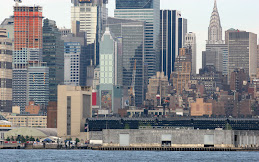According to a new analysis, New York's foreign born residents are less likely to have entered the country illegally. The analysis also cites that they are better educated and more likely to have health insurance.
The narrower socioeconomic gaps between immigrants and native-born Americans in New York may be one reason that the state has generally been more receptive to foreigners.
“That may help many immigrants integrate and affect the politics as well,” said Steven A. Camarota, research director for the Center for Immigration Studies in Washington, which favors reducing the influx from abroad.
The biggest income disparities between native and foreign-born residents were found in Arizona, Colorado, Texas and California, where immigration has generated more controversy.
In New York and New Jersey, the income differential between native and foreign-born residents was smaller than the national average.
The gaps between native and foreign-born residents of New York and New Jersey in education, poverty and health insurance coverage were also generally narrower than in other states.
Mr. Camarota, who prepared the analysis for the center, based mostly on census results, concluded that more than 10 million immigrants had entered the country since the beginning of the decade, more than half of them illegally. About one in eight residents of the United States is an immigrant, the highest proportion since the 1920s, when stricter limits were imposed.
New York State accounts for more than 1 in 10 immigrants in the country, second only to California. New Jersey is home to 1 in 20 of the nation’s immigrants.
New Jersey ranked third, after California and Texas, in the growth in immigrants since 2000. They now account for nearly 22 percent of the state’s population, the same proportion as in New York.
New York remains a magnet for immigrants, who arrive in fairly constant numbers. But the number who remain seems to be declining. The state’s total foreign-born population increased by 585,000 from 1995 to 2000, but by 262,000 since 2000. In New Jersey, the number of immigrants grew by 152,000 from 1995 to 2000 and by 588,000 since 2000.
While many politicians in New York and elsewhere were briefly incensed over Gov. Eliot Spitzer’s proposal to grant driver’s licenses to illegal immigrants, New York has been regarded as more generous in providing various benefits, regardless of whether immigrants are here legally. New York City has encouraged illegal immigrants to avail themselves of city public safety, health and other services by saying they would not be reported to immigration authorities.
In contrast to many other places, New York’s immigrant population is also more diverse.
The census does not ask immigrants whether they are here legally or not, but Mr. Camarota estimated the number of illegal immigrants by subtracting those who, by country or origin, military status and other variables, were likely to have arrived legally.
By those indicators, illegal immigrants represent 65 percent of the foreign-born population in Arizona, 50 percent in Texas, 39 percent in Colorado on the high end, ranging to 23 percent in New Jersey and 13 percent in New York.
One reason for the relatively low proportion in New York, he said, is that the state is farther from the Mexican border. Also, social networks in New York draw many more legal immigrants. And, he said, other studies have found that among the foreign-born people who are in New York illegally, more are likely to have overstayed their visas than to have entered the country illegally.
In New York City, 57 percent of children under 5 had foreign-born fathers, even more than in Los Angeles County. In New York State, according to the analysis, 49 percent of households headed by an illegal immigrant are enrolled in one welfare program or another, typically food assistance and Medicaid for their children.
Sunday, December 2, 2007
Study Finds Immigrants In New York Better Off
Posted by
Blogging New York
at
2:01 AM
![]()
Labels: immigration
Subscribe to:
Post Comments (Atom)



No comments:
Post a Comment